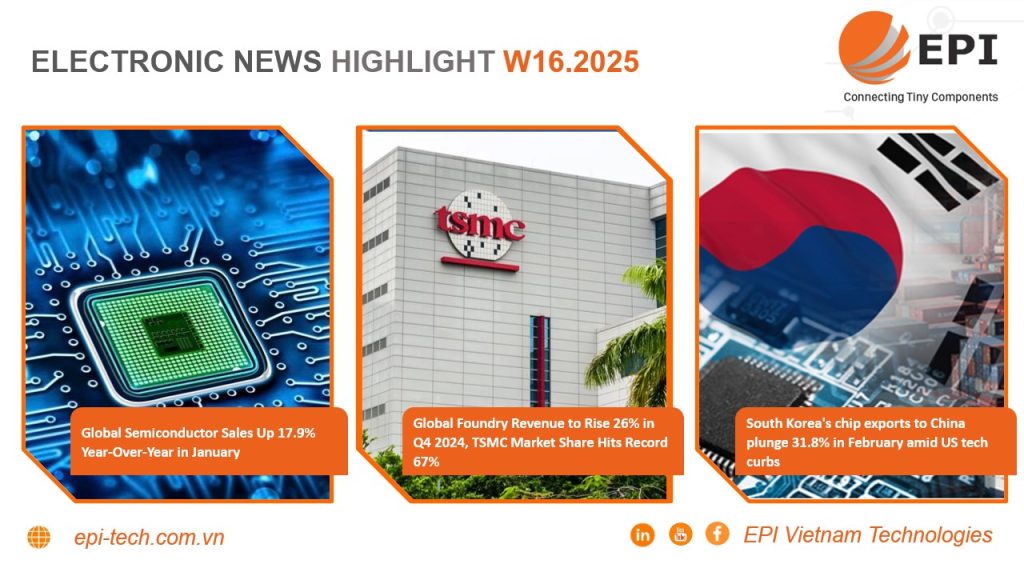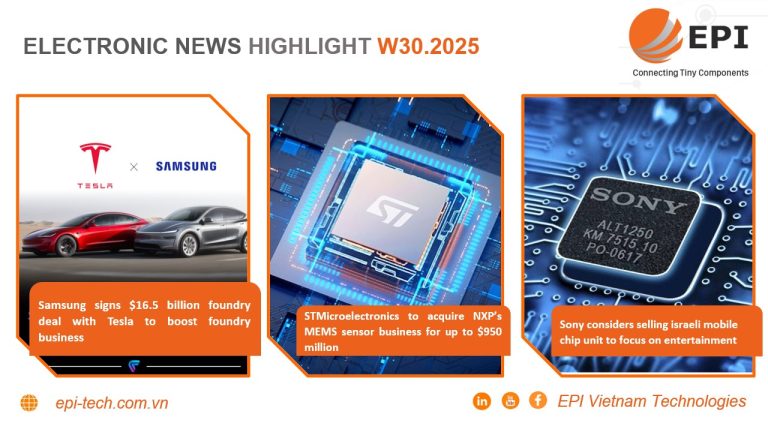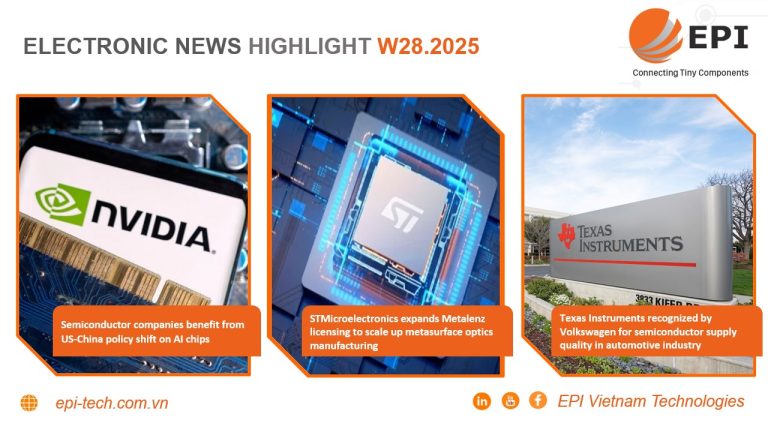ELECTRONIC NEWS HIGHLIGHT W16.2025

1. Global Semiconductor Sales Up 17.9% Year-Over-Year in January
The Semiconductor Industry Association (SIA) reported that global semiconductor sales reached $56.5 billion in January 2025, up 17.9% from $47.9 billion in January 2024 but down 1.7% from $57.5 billion in December 2024.
John Neuffer, president and CEO of SIA said: “After recording its highest annual sales volume ever in 2024, the global semiconductor market maintained strong momentum in January, posting the highest sales volume for any January on record despite a slight monthly decline” ,“Year-over-year sales increased more than 17% for the ninth consecutive month, driven primarily by a 50.7% increase in the Americas.”
By region, sales increased year-on-year in the Americas (+50.7%), Asia Pacific/All Other Regions (+9.0%), China (+6.5%) and Japan (+5.7%), while Europe saw a decline (-6.4%). Compared to the previous month, sales increased in Asia Pacific/All Other Regions (+1.6%) but decreased in Europe (-1.3%), China (-2.0%), Japan (-3.1%) and the Americas (-3.5%).
Learn more: Global Semiconductor Sales Up 17.9% Year-Over-Year in January
2. Global Foundry Revenue to Rise 26% in Q4 2024, TSMC Market Share Hits Record 67%
Global foundry revenue grew 26% year-on-year and 9% quarter-on-quarter in Q4 2024, driven by strong AI demand and a recovering Chinese market, according to Counterpoint Research.
Advanced nodes remain in high demand, particularly TSMC’s N3 and N5 processes, which have maintained high utilization rates. Meanwhile, foundries outside of China continue to struggle, with utilization rates hovering around 65% to 70%. The 12-inch wafer segment has seen a stronger recovery than the 8-inch segment, as automotive and industrial demand remains weak. However, demand for non-AI semiconductors is gradually recovering, particularly in the consumer electronics and PC sectors, supported by pre-emptive inventory build-ups due to U.S. tariffs and Chinese government subsidies.
TSMC maintained its dominance, expanding its market share to a record 67% in Q4 2024, up from 64% in the previous quarter. The company benefited from high utilization at its advanced nodes, particularly N3 and N5, driven by demand for AI accelerators and high-end smartphones.
Samsung Foundry ranked second but saw its revenue decline quarter-on-quarter, with its market share falling from 12% to 11%. Weak demand for Android smartphones and rising R&D costs related to advanced node development weighed on the company’s performance.
SMIC took third place, with revenue growth in line with expectations. The company benefited from recovering consumer electronics demand and China’s localization efforts. UMC ranked fourth, with steady wafer shipments supported by brisk consumer electronics orders. However, price pressure and the impact of the Taiwan earthquake weighed on margins, leading to a weaker Q1 2025 outlook.
GlobalFoundries ranked fifth, reporting steady results in Q4 2024. Strong wafer shipments offset seasonal weakness in the smartphone sector.
Learn more: Global Foundry Revenue to Rise 26% in Q4 2024, TSMC Market Share Hits Record 67%
3. South Korea’s chip exports to China plunge 31.8% in February amid US tech curbs
South Korea’s semiconductor exports to China fell sharply in February as the US tightened restrictions on tech exports to China. The decline has raised concerns about weakening global demand under pressure from US trade policies.
According to the South Korean Trade Ministry, chip exports to China fell 31.8% year-on-year in February, marking a steeper decline than the 22.5% drop recorded in January. The decline followed a brief recovery in 2024 that initially boosted South Korea’s economic growth.
The decline coincided with new U.S. export restrictions targeting China’s semiconductor industry. In December 2024, the U.S. Commerce Department imposed additional controls on high-bandwidth memory (HBM) chips, aimed at curbing China’s advances in artificial intelligence (AI) and other advanced technologies. As of the end of 2024, China accounted for about 40% of South Korea’s total technology exports.
In addition to geopolitical factors, structural changes in the semiconductor market have also contributed to the slowdown in exports. South Korea’s total semiconductor exports fell 3% year-on-year in February. Falling memory chip prices and industry-wide shifts in semiconductor manufacturing technology have added pressure on export growth. Ongoing challenges in chip exports pose risks to the South Korean economy. Analysts warn that trade tensions, including tariffs imposed by former US President Donald Trump, have weighed on South Korea’s economic performance.
Learn more: South Korea’s chip exports to China plunge 31.8% in February amid US tech curbs
#ASEAN #AsiaPacific #FarEast #distributor #Global #electronicdistributor #PCBA



 English
English  Tiếng Việt
Tiếng Việt 













